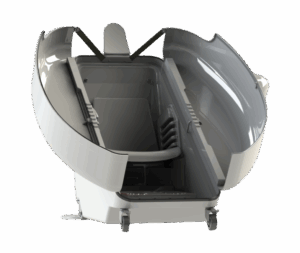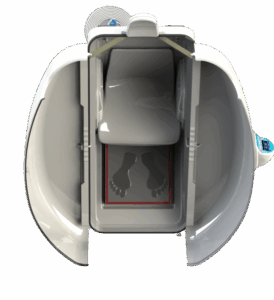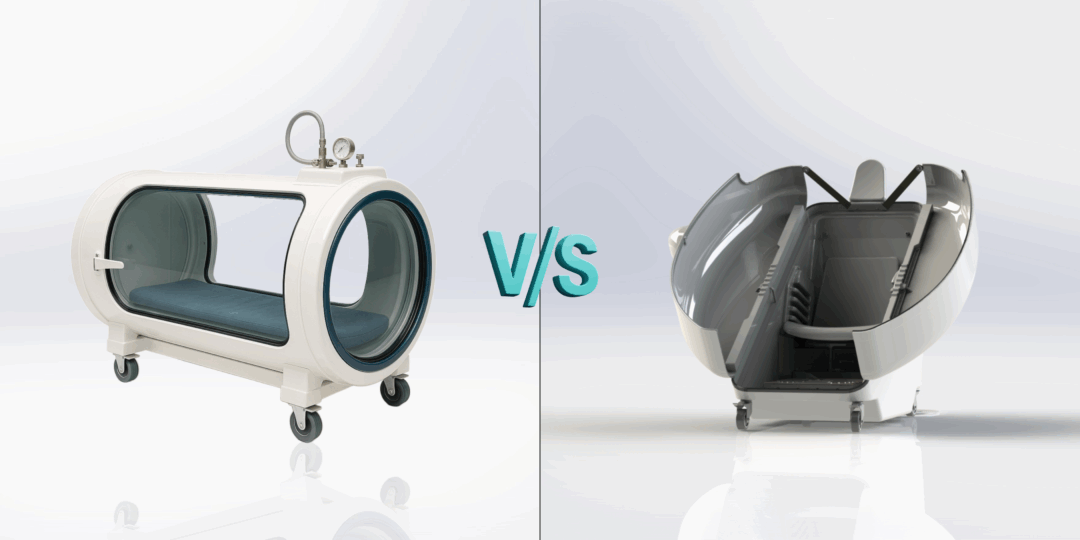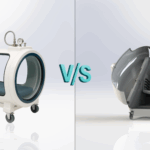In the evolving world of wellness, innovative therapies like hyperbaric oxygen chambers and ozone steam saunas are gaining popularity. Both offer unique health benefits, yet they cater to different wellness needs. If you are undecided which therapy – hyperbaric vs ozone saunas – is right for you, this guide explores the pros and cons of each to help you decide which suits your health goals best.
Hyperbaric Oxygen Chambers
How They Work:
First it’s good to note that there are different types, mHBOT (medium or mild hyperbaric) or HBOT/HOT (hyperbaric oxygen therapy chambers).
- HOT chambers deliver 100% oxygen at elevated atmospheric pressures (2 ATA) and is used in acute medical conditions and severe emergencies like air bubbles in blood streams, carbon monoxide poisoning or severe wounds. These chambers use hard-shelled medical-grade bodies that is very expensive ($50 000 – $150 000) and typically found in hospitals or specialised clinics as they require medical clearance and trained technicians.
- mHBOT chambers use softer materials, lower pressures (1 ATA – 1.4 ATA) and lower oxygen concentrations (24%-93%), resulting in lower/milder health benefits and results. Because mHBOT is what is more frequently used, the rest of the article will compare mHBOT to ozone saunas.
In both of the above chambers patients sit or lie down in a sealed chamber, where they breathe in pure oxygen, allowing for greater oxygen absorption in the body.
Pros:
- Enhanced Healing: Accelerates wound healing by boosting oxygen levels in blood and tissues, promoting tissue repair and regeneration.
- Neurological Benefits: May improve cognitive function and support recovery from brain injuries by increasing oxygen supply to the brain.
- Immune Support: Enhances white blood cell activity, potentially improving immune response.
Cons:
- Cost and Accessibility: Hyperbaric therapy chambers are more expensive than ozone saunas, typically costing 2-3 times more for mHBOT and 10 times more for HBOT.
- Contraindications: Not suitable for individuals with certain medical conditions such as lung disease or ear problems. Claustrophobia and barotrauma are also concerns.
- Time Investment: Sessions can be lengthy, often lasting about 60 to 90 minutes compared to 30 minutes for ozone.
- Space constraints: HBOT are large, bulky devices that’s not easily moveable. Even soft shell mHBOT devices are larger (specifically longer) than ozone steam saunas.
Applications for mHBOT:
- Infections: Mild Hyperbaric therapy can assist with infections that cause tissue death and non healing wounds like ulcers from diabetes. Although ozone therapy also significantly reduce ulcer areas, hyperbaric oxygen therapy have seen even better results (Study: Topical Hyperbaric Oxygen Therapy Versus Local Ozone Therapy in Healing of Venous Leg Ulcers)
- Increased performance and faster recovery: Increased performance and faster recovery: Providing more oxygen to cells leads to short-term performance gains and faster recovery after physical activity.
- Tissue treatment: It can help with the healing of tissue after skin grafts or skin flaps.
Some studies have seen similar results between Ozone and HBOT when it comes to tissue regeneration: [However, we were unable to determine any clear result that revealed the superiority of either HBOT or ozone. – Study: Effectiveness of hyperbaric oxygen and ozone applications in tissue healing in generated soft tissue trauma model in rats: an experimental study]
Ozone Steam Saunas
How They Work:
Ozone steam saunas combine steam therapy with ozone (an activated form of oxygen) exposure. The body, except for the head, is enclosed in a specialised hard shell steam sauna. Medical grade Ozone gas is then infused which gets absorbed through the skin. The ozone molecule has anti-viral, anti-bacterial, anti-fungal, anti-microbial, anti-inflammatory and antioxidant properties, making it a versatile therapy for treating a variety of conditions. Steam therapy in itself has many major health benefits, and some ozone saunas comes with other modalities like Far Infrared, Blue/Red Light therapy and/or oxygen breathing capabilities, providing a host of additional health benefits.
Pros:
- Wide scope of treatment: Due to the nature of ozone it provides beauty & cosmetic, sports and medical benefits.
- Detoxification: Promotes the release of toxins through sweating, thereby enhancing skin health and overall detoxification.
- More modalities/therapies in one device: Combining therapies treats a wider range of ailments and health stacking improves results as therapies work together.
- Immunomodulatory: Ozone therapy influences the immune system, thereby enhancing its functioning in some contexts. This can also affect the tumor microenvironment, preventing cancerous growths and assisting with recovery.
- Anti-viral: Inactivates viruses by oxidising it, inhibiting its ability to replicate and spread.
- Anti-bacterial: Ozone kills bacteria by oxidising their cellular components and disrupting their membranes.
- Anti-fungal and -microbial: Ozone has properties that help combat infections and improve skin conditions.
- Anti-inflammatory: A study indicates ozone therapy outperforms hyperbaric oxygen therapy to decrease inflammation, oedema and oxidative stress. (Study: Comparison of hyperbaric oxygen and medical ozone therapies in a rat model of experimental distal colitis)
- Antioxidant: Ozone therapy can combat oxidative stress. In another study comparing hyperbaric vs ozone saunas, ozone therapy proved superior in the Treatment of Lung Injury in Septic Rats.
- Improved blood circulation: The warmth from the steam boosts circulation, which can improve energy levels and skin appearance.
Cons:
- Accessibility: Ozone therapy is not widely available, making it hard to obtain in many locations.
- Lack of Scientific Consensus: While many users report benefits, scientific backing on some health claims remains limited.
- Cost: Ozone steam saunas are more cost effective than HBOT, but they still require a significant capital investment.
Applications for Ozone Saunas:
- Various ailments and diseases: Ozone therapy is credited with improvements for over 100 different conditions, from colds & flu to gout, multiple sclerosis to warts.
- Beauty, Skin & Cosmetic: From improving skin tone & blemishes to reducing cellulite and supporting body contouring.
- Detoxification: Arguably the most effective and efficient detox method available.
- Sports performance & Recovery: Cuts down on injury recovery time and increases physical performance.
- Dreaded disease treatments: Ozone can either assist with preventing, alleviating and/or reducing side effects of dreaded diseases like cancer, diabetes, HIV/AIDS and stroke.
Hyperbaric vs Ozone Saunas
 When choosing between hyperbaric oxygen chambers and ozone steam saunas, consider your specific health goals and any ongoing medical conditions. If you suffer from severe wounds or carbon monoxide poisoning, then the specialised Hyperbaric oxygen therapy (HBOT) is the route you must take.
When choosing between hyperbaric oxygen chambers and ozone steam saunas, consider your specific health goals and any ongoing medical conditions. If you suffer from severe wounds or carbon monoxide poisoning, then the specialised Hyperbaric oxygen therapy (HBOT) is the route you must take.
There is however an overlap between Ozone therapy and the benefits that mHBOT provides.
If one factors in that ozone therapy can treat more ailments, offers more therapies with similar or better results than mHBOT, and all that at a better price point, Ozone Steam Sauna therapy is the better option.
Ultimately, the decision between these two therapies depends on your personal wellness goals, budget, and medical suitability. Whether you’re recovering from an injury or looking to enhance your overall health, both therapies offer unique paths to wellness improvement.
🫁 Therapy Comparison Dashboard
Hyperbaric Oxygen Chambers vs. Ozone Steam Saunas
💰 Cost Comparison
Key Insight: HBOT costs 10x more than ozone saunas, while mHBOT costs 2-3x more.
⏰ Session Duration
Key Insight: Ozone sessions are 50% shorter, making them more time-efficient.
🎯 Treatment Applications
Key Insight: Ozone therapy treats 100+ conditions vs. specific applications for hyperbaric therapy.
📊 Therapy Benefits Comparison
🔍 Pressure & Oxygen Levels
📋 Detailed Therapy Comparison
| Aspect | HBOT | mHBOT | Ozone Steam Sauna |
|---|---|---|---|
| Cost Range | $50,000 - $150,000 | 2-3x Ozone cost | Most cost-effective |
| Session Duration | 60-90 minutes | 60-90 minutes | 30 minutes |
| Pressure (ATA) | 2.0 | 1.0 - 1.4 | Normal (1.0) |
| Oxygen % | 100% | 24% - 93% | Ozone infusion |
| Primary Use | Medical emergencies | Wound healing | 100+ conditions |
| Accessibility | Hospital/clinic only | Limited availability | Limited availability |
| Space Requirements | Large, bulky | Large, bulky | Compact design |







Leave a Reply